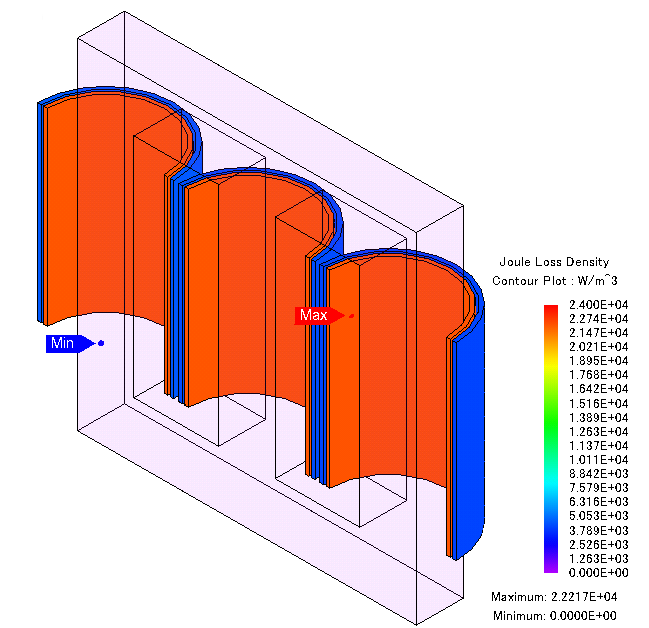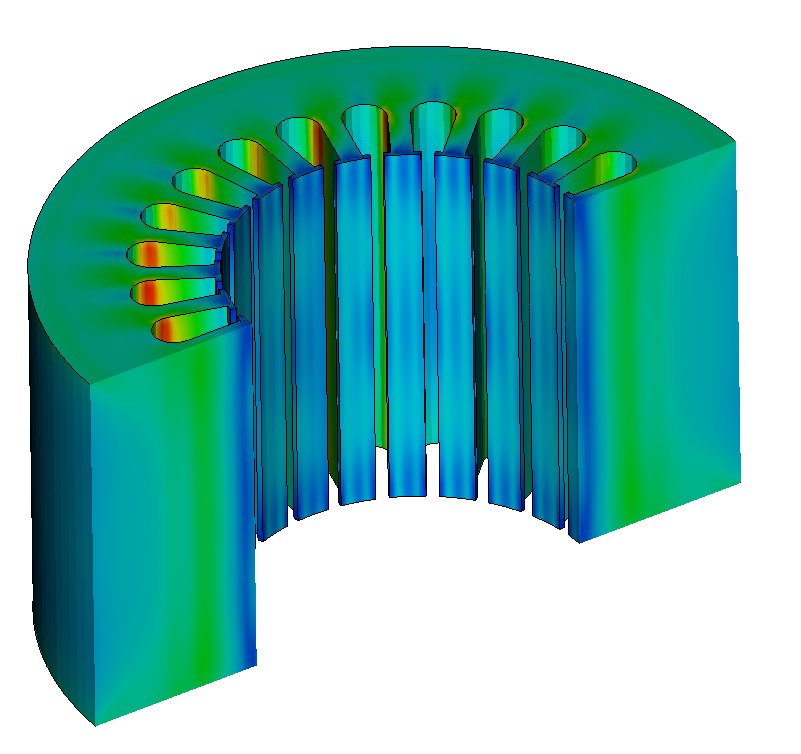The prediction of heating and cooling processes is of eminent importance in the development of electrical devices. The alternating current induces heating due to losses by Ohms' law and the usual mechanism for cooling is free convection. The increasing tendency of miniaturization requires to fully exploit the thermal potential of the materials involved.
Electrical Components
Tabbed contents
Reference Applications
Cooling of a 3-Phase Transformer
The thermal performance of an oil-immersed power transformer is governed by the oil flow for the transfer of heat generated in the windings and core towards the tank and the surrounding air.
A coupled JMAG-Fluent model has been used to detect the local hot spots within the device. The Joule losses calculated by JMAG are used as source terms for Fluent which conducts a thermal analysis taking into account the transport phenomena of heat including convection and conduction in fluids (coolant and air) and solid bodies (core and coils).
The resulting temperature distribution for the core and coils will affect the electrical property for the copper material which is temperature dependent and will induce a new distribution of Joule losses.
The temperature distribution in coils is very important because heat resistant designs are required for safety.
Electro-magnetic-induced Vibrations in Electrical Engines
The rotating electro-magnetic field in E-motors produces periodic forces which excite vibrations of the structure and noise in the surroundings. On the one hand, the electro-magnetic forces are computed in an EM-code. On the other hand, the vibrations are computed in CSD-codes. The tool MpCCI FSIMapper builds the missing link between both simulation disciplines: it maps the electro-magnetic forces from the EM-simulation as boundary condition to the structural vibration simulation.
Electric Arcs in Switching Devices
Switching arcs can be modeled using ANSYS EMAG to solve the magnetic field problem and Fluent to solve the fluid dynamics problem – coupled in volume through MpCCI CouplingEnvironment. Based on magneto-hydrodynamic (MHD) equations, a 3D model for a switching arc considering Lorentz forces, Ohmic heating, and radiation transport can be developed using a co-simulation approach.
Beside the co-simulation solution, which allows to subdivide a complex problem in smaller problems, the challenge still remains in modelling the plasma. The modelling of the electric arc behavior is governed by different stages, e.g. the arc motion, the arc elongation, the arc commutation, and arc cutting process. The inclusion of all these phenomena in the analysis requires to consider additional models like the arc root, the material erosion, etc. The resulting physical and material model of the electric arc provides methods and references for the optimization work of switching devices (MpCCI ArcLib).
Line Lightning Protection Devices
Overhead power lines need to be protected from lightning. A technical solution is to discharge energy in the air. Such lightning protection devices function with the conductivity of the pole and cross arms. A lightning surge (direct or induced) along the power line will create an electric arc between the line and the protection device. The arc will then go through a series of discharge chambers that will extend and extinguish it.
The Applied University of Rapperswil used the MpCCI CouplingEnvironment and the MpCCI ArcLib to realise a customised simulation model for its customer Streamer International AG (CH).
MpCCI Methods
Features for Electrical and Electronics Applications
- data transfer /exchange between periodic models exhibit different section shapes and positions (also full models)
- perform a Fourier transformation on transient data to create and map the loading for vibration analyses
- provide material data for modelling plasma in electric arc
- coupling of material properties
Solutions within R&D Projects
- Development of material database for plasma simulation
- Enhancements for electric arc simulation process: optimization of data transfer, mesh motion strategy
Software and Services
Service Offer
- Integration of commercial or inhouse codes into the MpCCI tools
- Integration of MpCCI tools into customer’s CAE workflow
- Adjusting MpCCI to customer’s specific requirements
- Extension of material database for plasma simulation
- Extension of the electric arc “ArcLib” model database
- Expertise in electric arc modeling
MpCCI CouplingEnvironment
The MpCCI CouplingEnvironment offers flexible solutions for multiphysical simulations. The combinable simulation codes for this application area are shown in the following table:
Discipline |
Codes |
|---|---|
Electro |
|
Heat Transfer |
|
Fluid |
|
Structure |
|
The supported quantities in this context are:
Quantities |
|
|---|---|
Electro |
|
Mechanical |
|
Thermal |
|
MpCCI FSIMapper
The MpCCI FSIMapper maps simulation results from a source to a target mesh. The following two tables list the supported source and target file formats for this application area.
Source Formats |
Quantities |
|
|---|---|---|
EM |
|
force |
Target Formats |
Target Analyses |
|
|---|---|---|
FEM |
|
deformation stress NVH fatigue |
List of additionally supported source and target file formats



